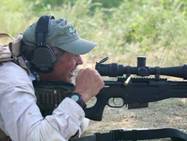
Making Ballistic Cards Using Density Altitude
by Linden B. (Lindy) SiskLast Revision December 5, 2009

|
Making Ballistic Cards Using Density Altitudeby Linden B. (Lindy) SiskLast Revision December 5, 2009 |
However, many shooters are leery of relying upon an expensive and relatively fragile electronic device in the field - and many shooters who are willing to do that would still like to have a backup for that system.
The purpose of this article is to explain how to print out a chart which would allow the shooter equipped with it and a method of calculating density altitude to go anywhere in the world and shoot long distances accurately without a ballistic computer. A Kestrel 4000 Weather Meter, or similar system manufactured by Brunton and others, will calculate density altitude - hereafter DA.
Density altitude is a simple concept, which originated in the aviation industry. Density altitude is defined as the altitude in the International Standard Atmosphere that has the same air density as the air being evaluated.
The International Civil Aviation Organization (ICAO) Standard Atmosphere (ISA) is an atmospheric model of how the pressure, temperature, density, and viscosity of the earth's atmosphere change over a wide range of altitudes. For your reference, a chart of the ISA is at the end of this article.
Author's Note: This article is a revision of one published in March of 2009. Since the publication of that original article, JBM Ballistics, an excellent online ballistics program, has developed a program which does the DA calculations for you. It is this author's recommendation that you use that program, rather than go through the manual steps listed below. However, you may still want to use some of the steps below, because at this time, the JBM Ballistics DA calculation does not go below a DA of -1000 feet, and people who live in cold climates may well need lower DA steps.
The JBM Ballistics DA card program is here
The instructions for use of that program are here. Pay particular attention to the specifications of muzzle velocity, which are entered in the boxes shown below:

If you have muzzle velocity data for different temperatures, enter them according to the instructions for Low Velocity and High Velocity. The program calculates a curve of muzzle velocity as a function of temperature.
Nota bene: The temperature the program uses to calculate the muzzle velocity will be the same as the ISA temperature for the density altitude you specify. That may not be the temperature at which you're shooting, which could lead to specification of an incorrect muzzle velocity.
If you don't have muzzle velocity data at different temperatures, enter the same muzzle velocity for both high velocity and low velocity, and put in the same temperature in both places.
If you are using the JBM program, the remainder of this article need not be read.
In order to calculate a DA chart, you must have access to two things. One is a method of calculating DA. A web-based application which can be used is located at the following web site:
http://wahiduddin.net/calc/calc_da_rh.htm
You must also have access to a ballistic calculator. If one is otherwise unavailable, one can be found online at the following web site:
JBM Ballistics Trajectory Calculations
First, you must decide on what range of density altitude steps to use. Density altitude computes to zero feet at what is known as the ICAO Standard Atmosphere at a barometric pressure of 29.92 inches of mercury, a temperature of 59 degrees F., and a relative humidity of zero. Temperature below 59, and barometric pressures below 29.92 inches of mercury, will result in a negative DA number. Therefore, I recommend that you start at -4000 feet DA or below.
I recommend that the initial computations use steps of 1000 feet in altitude. If you think that finer steps are desirable, it is easy to put the data from 1000 foot increments into an Excel or other spreadsheet, and interpolate between the 1000 foot steps.
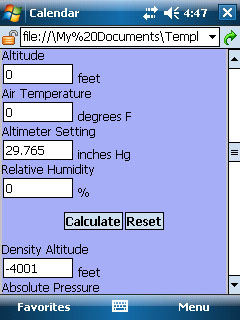
Note that it doesn't matter what combination of temperature, pressure, altitude, and relative humidity we put in the DA Calculator, as long as it results in the DA step that we want. However, to avoid confusing yourself, I recommend leaving the altitude and relative humidity set to zero, and change only the temperature and pressure.
Since the barometric pressure declines at a rate of about one inch of mercury per 1000 feet of elevation change, it's easy enough to just subtract one inch of mercury from the BP reading per step, and then just make slight adjustments to the number to make it come out even.
I will be using Field Firing Solutions, but Exbal, JBM, or any other program could be used. You will get the most accuracy if you have verified beforehand that the program produces data which is accurate for your load.
Below is the Presets page for FFS. Note that I have checked Stat on that page, which indicates that the barometric pressure I am putting in is the Station Pressure. If you are not familiar with the difference between Station Pressure and Sea-Level-Referenced Barometric Pressure, see my article Ballistic Software and Barometric Pressure. Note that I'm not putting in the altitude, because I'm always putting in the station pressure.
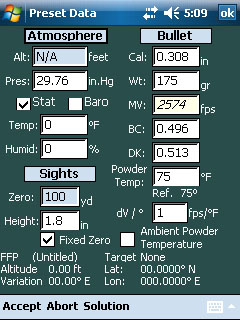
If you are using JBM Ballistics, in the section on atmosphere, put in the same temperature, pressure, and humidity you put in the DA Calculator, leave the altitude set to zero, and uncheck both the box which says "Std. Atmosphere at Altitude", and the one which says, "Pressure is Corrected".
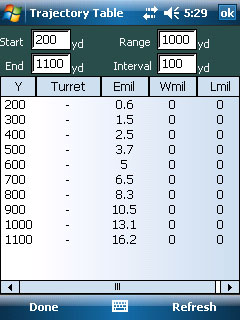
The elevation data is in milliradians, which is the kind of scope adjustments I have. If your scope adjusts in MOA, then that's what kind of data you'll want.
And that's basically the procedure. There is the elevation table for -4000 feet DA. I can copy that by hand to my dope book, put in in an Excel spreedsheet, or whatever I want to do with it.
To illustrate the procedure with another DA, I will do one for 5000 feet DA.
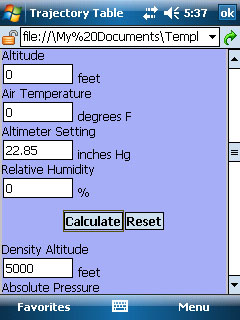
I could have adjusted the temperature as well. In the ICAO standard atmosphere, temperature decreases by about 3.6 degrees F. for every 1000 feet of elevation gain.
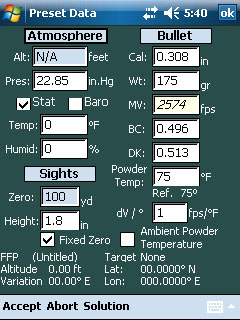
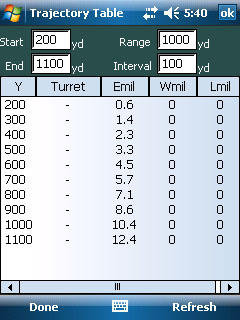
So, if my Kestrel calculates the DA as -4000 feet, and I'm shooting at a target which is 1000 yards away, I dial my scope to 13.1 mils. If I have that shot at a DA of 5000 feet, I will set my scope to 10.4 mils.
So, that's the procedure. Repeat the three steps for whatever increments of DA change you think appropriate, and write down the data.
To keep this simple, here are combinations of temperature and pressure that will give you DA steps from -4000 feet to 11,000 feet which you can put directly into your ballistic calculator. Leave the humidity set to zero. If you need other increments or steps outside this range, just use the online calculator.
| DA | Pressure | Temp(F.) |
| -4000 | 29.765 | 0 |
| -3000 | 28.925 | 0 |
| -2000 | 28.106 | 0 |
| -1000 | 27.303 | 0 |
| 0 | 29.92 | 59 |
| 1000 | 29.055 | 59 |
| 2000 | 28.208 | 59 |
| 3000 | 27.382 | 59 |
| 4000 | 26.573 | 59 |
| 5000 | 25.783 | 59 |
| 6000 | 25.011 | 59 |
| 7000 | 24.257 | 59 |
| 8000 | 23.521 | 59 |
| 9000 | 22.802 | 59 |
| 10000 | 22.099 | 59 |
| 11000 | 21.414 | 59 |
Note: In using the list above with a ballistic calculator, you will always set the humidity to zero. We know that in the real world, the humidity is not zero. However, the Kestrel or other meteorological instrument which calculates density altitude will use the ambient humidity to provide a correct DA calculation. Using zero while doing table development is simply for convenience.
Below is a partial result of my DA table for Black Hills 175 Match, which is a Sierra 175SMK fired from my rifle at a muzzle velocity of 2575 fps at 75 degrees F.
To use that table, I pull up the Density Altitude screen on my Kestrel. I select the nearest 500 foot step of DA, and follow that column down to the appropriate distance. Dial it up - and I'm done.
| Yds | -4000 | -3000 | -2000 | -1000 | 0 | 1000 | 2000 | 3000 | 4000 | ||||||||
| 200 | 0.6 | 0.6 | 0.6 | 0.6 | 0.6 | 0.6 | 0.6 | 0.6 | 0.6 | 0.6 | 0.6 | 0.6 | 0.6 | 0.6 | 0.6 | 0.6 | 0.6 |
| 300 | 1.5 | 1.5 | 1.5 | 1.5 | 1.5 | 1.5 | 1.5 | 1.5 | 1.5 | 1.5 | 1.4 | 1.4 | 1.4 | 1.4 | 1.4 | 1.4 | 1.4 |
| 400 | 2.5 | 2.5 | 2.5 | 2.5 | 2.4 | 2.4 | 2.4 | 2.4 | 2.4 | 2.4 | 2.4 | 2.4 | 2.4 | 2.4 | 2.4 | 2.4 | 2.3 |
| 500 | 3.6 | 3.6 | 3.6 | 3.6 | 3.6 | 3.6 | 3.5 | 3.5 | 3.5 | 3.5 | 3.4 | 3.4 | 3.4 | 3.4 | 3.4 | 3.4 | 3.4 |
| 600 | 5.0 | 5.0 | 4.9 | 4.9 | 4.8 | 4.8 | 4.8 | 4.8 | 4.7 | 4.7 | 4.7 | 4.7 | 4.6 | 4.6 | 4.6 | 4.6 | 4.5 |
| 700 | 6.5 | 6.5 | 6.4 | 6.4 | 6.3 | 6.3 | 6.2 | 6.2 | 6.1 | 6.1 | 6.0 | 6.0 | 5.9 | 5.9 | 5.9 | 5.9 | 5.8 |
| 800 | 8.3 | 8.2 | 8.1 | 8.1 | 8.0 | 7.9 | 7.8 | 7.8 | 7.7 | 7.7 | 7.6 | 7.5 | 7.4 | 7.4 | 7.3 | 7.3 | 7.2 |
| 900 | 10.5 | 10.4 | 10.2 | 10.1 | 10.0 | 9.9 | 9.7 | 9.7 | 9.6 | 9.5 | 9.4 | 9.3 | 9.2 | 9.1 | 9.0 | 8.9 | 8.8 |
| 1000 | 13.1 | 12.9 | 12.7 | 12.5 | 12.3 | 12.2 | 12.0 | 11.9 | 11.8 | 11.7 | 11.5 | 11.4 | 11.2 | 11.1 | 10.9 | 10.8 | 10.7 |
| 1100 | 16.2 | 15.9 | 15.6 | 15.4 | 15.1 | 14.9 | 14.7 | 14.5 | 14.3 | 14.1 | 13.9 | 13.7 | 13.5 | 13.4 | 13.2 | 13.0 | 12.8 |
Now that you understand the process, note that if you don't want to go through all of this exercise, JBM Ballistics now has a page which will produce density altitude ballistics cards for you. It's here: JBM Density Altitude Ballistics Cards
I wouldn't. For one thing, there are many combinations of temperature and pressure that will give you the same Density Altitude - but muzzle velocity is also a function of temperature. So, using this method, you must accomodate the fact that your muzzle velocity will be slower at lower temperatures. How much? That depends on the powder and primer you use. I have seen muzzle velocities which vary by as little at 0.6 feet/second per degree, and by as much at 5 feet/second per degree.
The only way to know is to test your load over a chronograph at different temperatures. Once you have done that, experiment with your ballistic calculator to see how much difference it makes. One rule of thumb is to change the DA by 500 feet for every 15 fps change in muzzle velocity. If the muzzle velocity has increased with respect to your baseline temperature, which is usually the case at a higher temperature, step up in DA. If the muzzle velocity has decreased with respect to your baseline temperature, step down in DA.
The only way to know for sure is to test the response of your load with temperature.
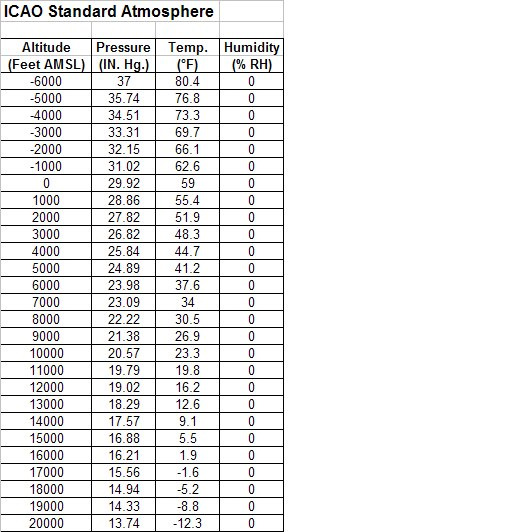 "
"
This file is: http://www.arcanamavens.com/LBSFiles/Shooting/Downloads/DA/index.html
Permission is granted to print or photocopy the entire article intact, including this notice. All other rights reserved.